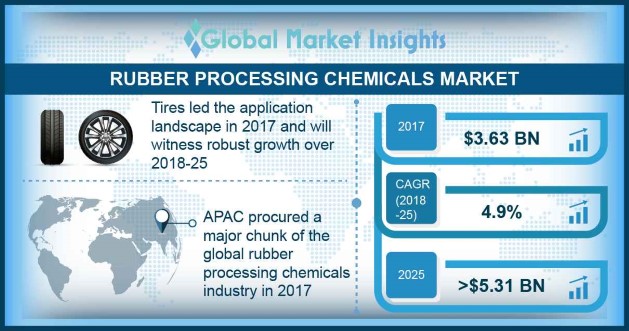Home > Chemicals & Materials > Specialty Chemicals > Custom Synthesis > Rubber Processing Chemicals Market
Rubber Processing Chemicals Market Size
- Report ID: GMI1405
- Published Date: Oct 2018
- Report Format: PDF
Rubber Processing Chemicals Market Size
Rubber Processing Chemicals Market size was more than USD 3.5 billion in 2017 and will witness 4.9% CAGR during the forecast timespan.
Global rubber processing chemicals market will be primarily driven by the growing automotive sales across the globe in the coming years. Tire manufacturing is the biggest application segment of the industry. It holds over 70% share as compared to non-tire components. In 2016, the global tire market volume crossed 3.4 billion units and is expected to reach 3.66 billion units by 2020. This exponential increase in tire demand will be primarily driving product demand over the forecast period.
The growing use of rubber in floor coverings, sound insulation, roofing materials and sealants in construction industry will fuel product demand over the next few years. Rubber processing chemicals are also used for conveyor belts, footwear & ball bladders, gaskets, seals, O-rings, gum, hoses and lining & coatings. These applications come under the non-tire segment of rubber. Rapid industrialization in Asia Pacific, particularly in China and India, will be prominently driving demand for these industrial components (conveyor belts, hoses, gaskets, adhesives, asphalt, etc.) in the coming years, which will subsequently augment rubber demand, leading to rubber processing chemicals market size growth during the forecast timeframe.
| Report Attribute | Details |
|---|---|
| Base Year: | 2017 |
| Rubber Processing Chemicals Market Size in 2017: | 3.5 Billion (USD) |
| Forecast Period: | 2018 to 2025 |
| Forecast Period 2018 to 2025 CAGR: | 4.9% |
| 2025 Value Projection: | 5.31 Billion (USD) |
| Historical Data for: | 2013 to 2017 |
| No. of Pages: | 270 |
| Tables, Charts & Figures: | 272 |
| Segments covered: | Product, Application and Region |
Stringent regulations regarding use of rubber processing chemicals is likely to hamper product demand over the next few years. The processing chemicals used for rubber are hazardous for environment and aquatic life as most of them are discharged in water bodies. EPA and European Commission have put down strict rules for use and disposal of these chemicals. It may obstruct the market growth over the forecast duration.

